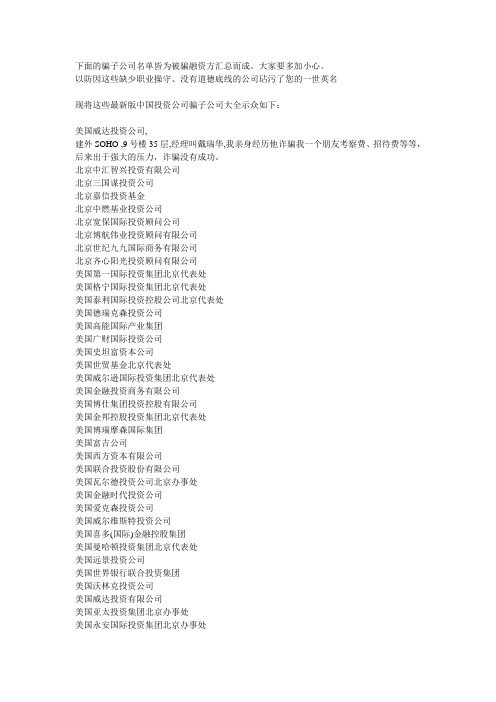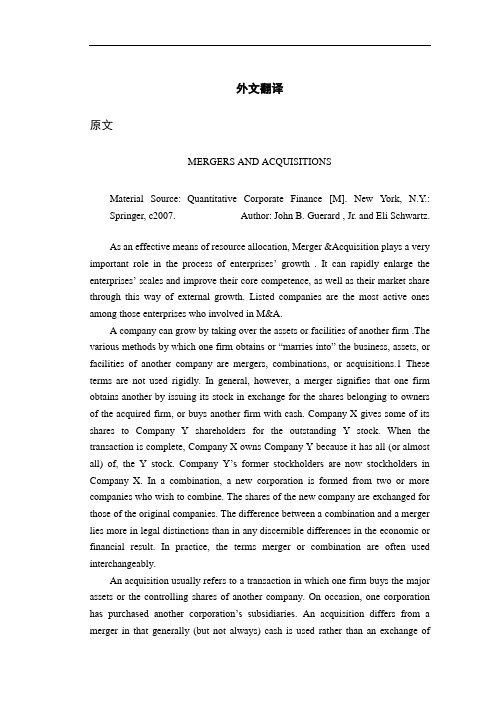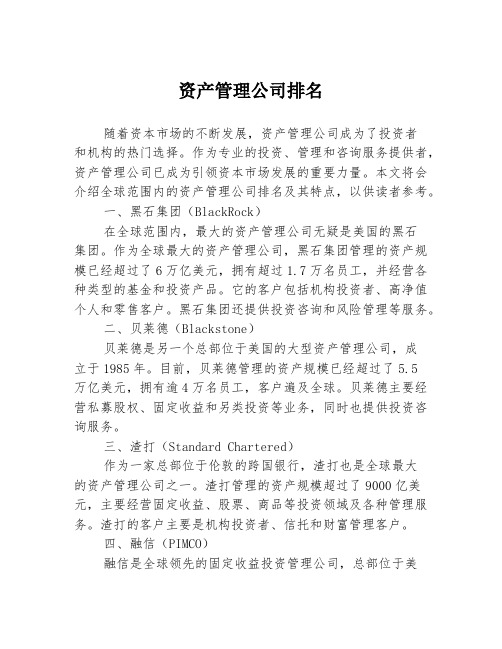康德资本集团(Koderan International Markets Limited)简介
- 格式:docx
- 大小:151.93 KB
- 文档页数:3


外文翻译原文MERGERS AND ACQUISITIONSMaterial Source:Quantitative Corporate Finance [M]. New York, N.Y.: Springer, c2007. Author:John B. Guerard , Jr. and Eli Schwartz.As an effective means of resource allocation, Merger &Acquisition plays a very important role in the process of enterprises’growth . It can rapidly enlarge the enterprises’ scales and improve their core competence, as well as their market share through this way of external growth. Listed companies are the most active ones among those enterprises who involved in M&A.A company can grow by taking over the assets or facilities of another firm .The various methods by which one firm obtains or “marries into” the business, assets, or facilities of another company are mergers, combinations, or acquisitions.1 These terms are not used rigidly. In general, however, a merger signifies that one firm obtains another by issuing its stock in exchange for the shares belonging to owners of the acquired firm, or buys another firm with cash. Company X gives some of its shares to Company Y shareholders for the outstanding Y stock. When the transaction is complete, Company X owns Company Y because it has all (or almost all) of, the Y stock. Company Y’s former stockholders are now stockholders in Company X. In a combination, a new corporation is formed from two or more companies who wish to combine. The shares of the new company are exchanged for those of the original companies. The difference between a combination and a merger lies more in legal distinctions than in any discernible differences in the economic or financial result. In practice, the terms merger or combination are often used interchangeably.An acquisition usually refers to a transaction in which one firm buys the major assets or the controlling shares of another company. On occasion, one corporation has purchased another corporation’s subsidiaries.An acquisition differs from a merger in that generally (but not always) cash is used rather than an exchange ofsecurities.A firm which either by the exchange of securities or purchase owns or controls subsidiary companies but does not engage in activities of its own is called a holding company. The holding company differs from a parent company in that the parent company has production functions of its own whereas a holding company exists mainly to control or coordinate its subsidiaries.No new net financial holdings are created in the economy by any of the forms of merger or acquisition [Mossin (1973)]. If the transaction involves an exchange of st ock, the supply of shares of one company’s stock is eliminated and is replaced by the shares of the surviving company. If the transaction is financed by cash, cash holdings by individuals go up, but cash held by corporations goes down; the supply of outstanding securities in the hands of the public goes down, but the amount held by corporations rises. If a corporation floats new securities to obtain funds to finance its acquisition, the process is slightly roundabout, but the net results are the same. One section of the public surrenders its cash for new corporate securities; another group gives up a different issue of securities for cash.A few studies have examined the long-term financial performance of firms involved in M&A. Ravenscraft and Scherer (1989) found that the financial performance of target firms deteriorated during the post-merger period compared to that of the pre-merger period. Herman and Lowenstein (1988) examined the post-takeover performance of hostile takeovers and found contradictory results for takeovers in different time-periods. Both these studies used primarily2 accrual accounting variables, which could be affected by the accounting choices for consolidation of financial statements. Healy, Palepu and Ruback (1992) examined post-merg er performance using the “median operating cash flow return on actual market value for 50 combined target and acquirer firms in years surrounding mergers completed in the period 1979 to mid-1984” and found that“the merged firms have significant improvements in post-merger asset productivity relative to their industries leading to higher operating cash flow returns .There is a strong positive relation between post-merger increases in operating cash flows and abnormal stock returns at merger announcements, indicating that expectations of economic improvements underlie the equity revaluations of the merged firms.” The study also found that “Although cash flow performance improves on average, a quarter of the sample firms have negative post-merger cash flow cha nges.”The reader probably expects the stockholders of acquired firms to earn positive,and highly significant excess returns. After all, merger premiums rose to 25-30 percent during the 1958-1978 period [Dodd and Ruback (1977)]. What about the acquiring f irms? If the acquired firms’stockholders profit handsomely from a merger, should not the acquiring firms stockholders lose? Are mergers zero-sum events? Is wealth created by mergers? Let us examine much of the empirical evidence. Mandelker (1974) put forth the Perfectly Competitive Acquisitions Market (PCAM) hypothesis in which competition equates returns on assets of similar risk, such that acquiring firms should pay premiums to the extent that no excess returns are realized to their stockholders. The PCAM holds that only the acquired firms’ stockholders earn excess returns. However, Mandelker studied mergers of 241 acquiring firms during the 1948-1967 period, and found that acquiring firms’ stockholder earned 5.1 percent during the 40 months prior to the mergers, but excess returns decreased by 1.7 percent in the 40 months following the merger. Positive net excess returns (3.7 percent) were earned by the acquiring firms in the Mandelker study. Thus, Mandelker found no evidence that acquiring firms paid too much for the acquired firms. Moreover, the acquired firms’ stockholders realized excess returns of 12 percent for the 40 month period prior to the merger, and 14 percent for the seven-month period prior to the merger.The Mandelker results have been substantiated by much of the empirical literature. Dodd and Ruback (1977) found that successful acquiring firms’ stockholders gained 2.8 percent in the month before the merger announcement during the 1958-1978 period, whereas the successful acquired firms’ stoc kholders gained 20.9 percent excess returns. Dodd and Ruback found that the acquired firms’ stockholders gained 19.0 percent even if the merger was unsuccessful, whereas the acquiring firms’ stockholders gained less than one percent. The empirical evidence for the 1973-1998 period is consistent, from 20 months prior to the merger to its close, the combined firms’ stockholders gain approximately 1.9 percent [Andrade, Mitchell, and Stafford (2001)]. Moeller, Schlingemann, and Stulz (2003) analyzed 12,023 mergers during the 1980-2001 period and found a 1.1 percent gain to acquiring firms shareholders.Mergers may enhance stockholder wealth; however, whereas Andrade, Mitchell, and Stafford further found that the target, or acquired stockholders gained about 23.8 percent for the 20 month period, consistent across the decades of the 1973-1998 period, the acquiring firms’ stockholders lost about 3.8 percent, during the corresponding 20 month period. For the largest merger in U.S. history prior to 1983,Ruback (1982) found that DuPont lost 9.89 percent ($789 million of stockholder wealth) in the month prior to the merger announcement whereas Conoco stockholders gained 71.2 percent ($3201.2 million) for the two-month period prior to the successful DuPont merger announcement.Do mergers affect the firms’ operations? Hall (1993) found that research and development (R&D) activities were not impacted significantly by mergers. Hall found no lessening of R&D spending. Healy, Palepu, and Ruback (1992) reported that mergers seeking strategic takeovers outperformed financially-motivated takeover. Strategic takeovers generally involved friendly takeovers financed with stock whereas financial takeovers were hostile takeovers involving cash payments. During the 1979-1982 period , for the 50 largest mergers, Healy, Palepu, and Ruback found that strategic takeovers made money for the acquiring firms whereas financial takeovers broke even. Acquiring stockholders of strategic acquisitions made 4.4 percent for five years post-merger, assuming no premiums paid, whereas financial takeovers earned the acquiring stockholders 1.1 percent. The premiums paid in financial takeovers were higher (45%) than in strategic takeovers (35%), and the synergies were lower in financial takeovers. Trimbath (2002, p. 137) found “no significant merger effect on net profit, operating profit, or market value” when analyzing firms purchased by Fortune 500 firms during the 1981-1995 period. Mergers generate a net gain for stockholders in the U.S. economy, but one prefers to be a stockholder in the acquired, rather than the acquiring, firm.Mergers and acquisitions have been a major source of corporate growth and economic concentration during the past 125 years. The empirical evidence is mixed; most acquired firms’ st ockholders profit handsomely with excess returns exceeding 25 percent whereas acquiring firms’ shareholders earn excess returns of only about 1 to 1.50 percent.Although mergers, combinations, and acquisitions are exciting events of great interest to the financial community, there is much uncertainty that whether M & A improves the operating performance of listed companies. Therefore, we need to further research.译文并购资料来源:定量公司财务管理[米].纽约,纽约州:斯普林格委,2007作者:小盖哈约翰B和礼施瓦茨作为资源配置的有效手段,并购在企业成长的过程中起着非常重要的作用。


WORLD CAPITAL MARKET美国万通投资银行万通投资银行的成功案例美国万通投资银行管理团队曾就职,美国高盛投资银行,千僖投资银行,罗斯资本,UBS,普天寿, BEAR STERNS 等,操作过上亿美金的IPO, 如中华网的上市(),到多家中国企业的海外上市融资, 如:中华网的上市: 我们从1996年起, 就开始为中华网准备上市工作, 那时这家公司还只有四个人的工作团队. 中华网是从中国互联网公司 (CIC) 中分拆出来. 千禧公司(Millennium)的经理合伙人, Jonathan Mork 先生 是这家公司的副总裁. 我们是以中华网 的投资银行顾问和华尔街战略顾问的身份, 在1996 年加入进来.中华网取得的成绩包括:· 取得了5000 万美金的上市前融资· 9660 万美金的公开发行上市的融资· 4 亿美金的二次发行融资· 1 亿美金的子公司分拆的回报中华网的成功取决于以下几个因素:· 美国上市前的一流准备· 上市战略符合华尔街投资者的要求· 超质素的包装· 西方式的管理· 比Yahoo 更健康的财务状况· 发起者引发了华尔街的广泛的兴趣我们帮助中华网建立了整套的华尔街上市战略. 中华网虽然并不是最好的网站, 但是由于千禧公司的参与,华尔街认为它是中国的最好的电子商务网站. 在首次公开发行上市时, 中国互联网信息中心将中华网在网站受欢迎程度的排名列为十七, 而Yahoo!的排名是第一. 这并不妨碍中华网的股权融资受到非常多 的 奖项. 这些奖项包括: <国际融资回顾> 的亚洲和太平洋地区的年度首次公开发行的新兴公司市场奖; <亚洲资产> 的最佳首次公开发行奖; 在香港的<国际股市回顾> 的最佳股权发行奖; 以及<亚洲财经智慧>的股权发行的杰出奖.我们在中华网的工作包括以下几个方面:· 业务战略· 协调行动 (业务和投资者关系)· 定位和包装· 信用的增强我们总结了中华网在美国的上市经验:· 一个成功的故事· 上市战略必须可信和吸引人· 包装必须是西方的· 千禧认为: 过度的包装是经常需要的· 中国的上市标准比较低· 美国的发起人是关键· 商业银行家 需准备上市前的销售· 管理层亦需做好各种准· 同西方的合资公司可以增强可信度.我们帮助中华网重新组建了它的商业模式. 它一开始是以网络服务供应商帮助中国提供互联网的连接. 我们帮助中华网做到了:· 将公司重新定位成为中国提供收费的内容服务商· 将公司重新定位成一体化的电子商务服务商 ( 包括: 商业网络的方案, 互联网广告, 网站等) · 将公司改组成更加吸引人在我们和中华网管理层的共同努力下, 三年后, 这家公司在1999年7月12日在那斯达克上市. 它取得了9660 万美金的现金. 430 万股票定价在20 美金每股. 在当天收市时它的价格已经上升到了67.10 美金每股. 在路演结束时它已经取得了40 亿美金的超额认购.中华网的股票在1999年12月14日, 每股分拆成两股. 分拆前的股价为159.87 美金每股.中华网在2000 年1月21 日进行了二次发行. 这次在每股不低于77 美金情况下共募集到了4 亿美金. 我们继续在为中华网提供不同国家间的收购兼并咨询服务 和上市后的支持服务.深圳纳伟仕集团美国万通投资银行于2008年初担任纳伟仕智能媒体技术集团独家海外上市顾问,该公司成功在美国募集1300万美元,资金已经于9月初到帐,2008年内将在美国主板AMEX上市,万通投资银行董事长徐明先生在该上市公司持有原始股份。

以下是一些常见的经贸英语词汇:- Economy 经济- Trade 贸易- Commerce 商业- Business 商业,生意- Market 市场- Supply and demand 供求- Profit 利润- Loss 损失- Inflation 通货膨胀- Unemployment 失业- Interest rate 利率- Exchange rate 汇率- Import 进口- Export 出口- Tariff 关税- Trade deficit 贸易逆差- Trade surplus 贸易顺差- Free trade 自由贸易- Protectionism 保护主义- Globalization 全球化- International trade 国际贸易- Economic growth 经济增长- Economic development 经济发展- Economic policy 经济政策- Fiscal policy 财政政策- Monetary policy 货币政策- Capital 资本- Investment 投资- Stock market 股票市场- Bond 债券- Entrepreneur 企业家- Corporation 公司- Partnership 合伙企业- Franchise 特许经营- Small business 小企业- Startup 创业公司- Merger and acquisition (M&A) 并购- Supply chain 供应链- Logistics 物流- Distribution 分销- Wholesale 批发- Retail 零售- E-commerce 电子商务- Digital economy 数字经济- Intellectual property (IP) 知识产权- Patent 专利- Trademark 商标- Copyright 版权- Licensing 许可证- Contract 合同- Negotiation 谈判- Bid 竞标- Auction 拍卖- Deal 交易- Invoice 发票- Payment 付款- Credit 信用- Debtor 债务人- Creditor 债权人- Bankruptcy 破产- Audit 审计- Accounting 会计- Budget 预算- Finance 金融- Venture capital (VC) 风险投资- Private equity (PE) 私募股权- Angel investor 天使投资人- Stock option 股票期权- Dividend 股息- Bonus 奖金- Salary 薪水- Wage 工资- Cost 成本- Price 价格- Profit margin 利润率-Markup 加价- Discount 折扣- Marketing 营销- Advertising 广告- Brand 品牌- Customer 顾客- Sales 销售- Market research 市场调研- Product development 产品开发- Quality control 质量控制- Packaging 包装- Distribution channel 分销渠道- Supply chain management (SCM) 供应链管理- Logistics management 物流管理- Inventory management 库存管理- Just-in-time (JIT) 准时制- Lean manufacturing 精益生产- Total quality management (TQM) 全面质量管理- Six Sigma 六西格玛- ISO 9000 国际标准化组织9000 系列标准- ERP 企业资源规划系统- CRM 客户关系管理系统- SCM 供应链管理系统- B2B 企业对企业电子商务- B2C 企业对消费者电子商务- C2C 消费者对消费者电子商务- Online payment 在线支付- Digital wallet 数字钱包- Cybersecurity 网络安全- Data protection 数据保护- Privacy 隐私- Encryption 加密- Cloud computing 云计算- Artificial intelligence (AI) 人工智能- Blockchain 区块链- Big data 大数据- Internet of Things (IoT) 物联网- 5G 第五代移动通信技术这些只是经贸英语词汇中的一部分,经贸领域非常广泛,涉及到众多专业和行业,因此还有很多其他的词汇和术语。

资产管理公司排名随着资本市场的不断发展,资产管理公司成为了投资者和机构的热门选择。
作为专业的投资、管理和咨询服务提供者,资产管理公司已成为引领资本市场发展的重要力量。
本文将会介绍全球范围内的资产管理公司排名及其特点,以供读者参考。
一、黑石集团(BlackRock)在全球范围内,最大的资产管理公司无疑是美国的黑石集团。
作为全球最大的资产管理公司,黑石集团管理的资产规模已经超过了6万亿美元,拥有超过1.7万名员工,并经营各种类型的基金和投资产品。
它的客户包括机构投资者、高净值个人和零售客户。
黑石集团还提供投资咨询和风险管理等服务。
二、贝莱德(Blackstone)贝莱德是另一个总部位于美国的大型资产管理公司,成立于1985年。
目前,贝莱德管理的资产规模已经超过了5.5万亿美元,拥有逾4万名员工,客户遍及全球。
贝莱德主要经营私募股权、固定收益和另类投资等业务,同时也提供投资咨询服务。
三、渣打(Standard Chartered)作为一家总部位于伦敦的跨国银行,渣打也是全球最大的资产管理公司之一。
渣打管理的资产规模超过了9000亿美元,主要经营固定收益、股票、商品等投资领域及各种管理服务。
渣打的客户主要是机构投资者、信托和财富管理客户。
四、融信(PIMCO)融信是全球领先的固定收益投资管理公司,总部位于美国加利福尼亚州纽波特海滩。
融信管理的资产规模超过了1.8万亿美元,主要经营固定收益投资、另类投资和股权投资等业务。
融信的客户主要是机构投资者、政府和大型企业客户。
五、富达(Fidelity Investments)富达是全球领先的财富管理公司之一,成立于1946年,总部位于美国马萨诸塞州波斯顿。
富达管理的资产规模超过了3000亿美元,经营股票、养老金和储蓄计划等业务。
富达的客户主要是零售客户和员工福利计划。
六、先锋(Vanguard)先锋成立于1975年,总部位于美国宾夕法尼亚州马尔文,是全球最大的互惠基金公司之一。
CP市場、コマーシャルペーパー市場商业本票市场 Commercial papers market Exit(売却) 退出 ExitFOF,ファンドオブファンズ FOF,基金中的基金 FoF(Fund of Fund)GP、無限責任出資者(ゼネラルパートナー)普通合伙人 General ParterIPO、新規株式公開首次公开募股IPO、Initial Public OfferingIRR(内部収益率)内部收益率 Internal Rate of ReturnLP,有限責任出資者(リミテッドパートナー) LP,有限合伙人 Limited Partner M & A 買収合併购并 Merger & AcquisitionPE(プライベートエクイティ)私募股权 Private EquityPIPE、パイプ上市后私募投资 private investment in public equity,PIPE Pre-IPO資本 Pre-IPO资本 Pre-IPO Investment capitalTMT 电信、媒体和科技 Telecommunication,Media,TechnologyVC、ベンチャー・キャピタル创业投资(创投)、风险投资 Venture capitalアジア金融危機亚洲金融风暴 Asian Financial Crisisアジア太平洋オペレーションセンター亚太运营中心ROC Regional operation centerアントレプレナー起业家イノベーション创新インフレ通货膨胀ウィルソン威尔逊ウォールストリート华尔街オープン・マーケット公开市场 Open marketオプション选择权 Optionsクリーンテクノロジー清洁技术 clean technologyクロスボーダーM&A跨国并购 cross-border M&Aコモディティー・スワップ商品交换 Commodity swapサブプライムローン次级贷款,次贷 subprime loanサブプライムローン次级按揭 subprime lendingサブプライム住宅ローン次级抵押贷款 subprime mortgage loanシステミックリスク系统性风险次世代エネルギー新能源 next-generation energyスタグフレーション停滞性膨胀 Stagflationスタグフレーション滞胀(停滞性通货膨胀) Stagflationストックオプション股票期权スワップ・ポイント换汇点 Swap pointソフト・ローン软性贷款 Soft loanターンアラウンド・ファンド重振资本基金 Turnaround Fundダウジョーンズ道琼斯ディーラー市場经纪商市场 Dealer marketデフレ通货紧缩 deflationデフレスパイラル通货紧缩的恶性循环ナスダック纳斯达克年金基金养老金基金 pension fund発展資本发展资本 development capitalファミリービジネス系投資会社家族投资机构フィナンシャル・グループ金融集团 Financial groupフェデラルファンド・マーケット联邦资金市场 Federal funds marketフォックスコン富士康不動産投資不动产投资 real-estate investmentブリッジファイナンス、つなぎ融資过桥融资 bridge finance不良債権不良债权 distressed debtヘッジファンド对冲基金 hedge fundホット・マネー热钱 Hot moneyマネー・ロンダリング、不正資金の浄化洗钱 Money launderingメザニンキャピタル夹层资本 Mezzanine Capitalラオックス乐购思レーガノミックス供给面经济学、里根经济学レナウン瑞纳レバレッジド・バイアウト杠杆收购 leveraged buyout,LBOレバレッジ比率杠杆率異業種連合异业结合,异业联盟 CROSS-INDUSTRY ALLIANCE企業買収ファンド并购基金 buyout/buyin fund機会コスト机会成本 Opportunity cost起債市場、発行市場、生産者市場初级市场,新发行市场 Primary market金融監督機能金融监督管理功能金融建て直し基金金融重建基金 financial reconstruction fund金融市場、マネー・マーケット货币市场 Money market金融持ち株会社金融控股公司 financial holding company金融派生商品、デリバティブ衍生性金融商品 Derivative,Derivative financial instrumentsDerivative products銀行引受手形市場银行承兑汇票市场 Banker's acceptance market限界効用边际效用 Marginal utility顧客市場、場外市場议商市场 Negotiated market公定歩合操作、割引率政策重贴现率政策 Discount rate policy国債市場国库券市场 Treasury market財政てこ入れ财务扛杆操作 financial stimulation財政難财务困境 financial difficulties山東如意山东如意資産収益率资产报酬率 ROA、Return on asset資本市場、キャピタル・マーケット资本市场 Capital market自己資本収益率净值报酬率 ROE、Return on equity準備金准备金 Reserves純資産価値净资产价值 Net asset value消費者余剰消费者剩余 Consumer surplus上海富客斯実業(フォックスタウン)富客斯实业譲渡可能預金証書(NCD) 可转让定期存单(NCD) Negotiable certificate deposit 信用の質授信品质 Credit quality信用割当信用分配 Credit rationing信用限度額信用限度 Credit line信用組合信用合作社 Credit association union生産者余剰生产者剩余 Producer surplus先物期货 Futures選択的信用統制选择性信用管制 Selective credit control蘇寧電器苏宁电器第二次市場、セコハン市場、流通市場次级市场,流通市场 Secondary market特別交換レート協定特别汇兑协定 Special exchange rate agreement表面利率票面利率 Coupon rate不良貸付、焦げ付き融資逾期放款 Non-performing loans不良貸付の解消打销呆帐変動為替相場浮动汇率 Floating exchange rate連邦預金保険会社、FDIC 美国联邦存款保险公司 Federal Deposit Insurance Corporation補遺リーマンショック雷曼兄弟破产投資ポートフォリオ投资组合グロースキャピタル成长资本 growth capitalシード种子期 seedスタートアップ起步期、导入期アーリー早期グロース成长期レイター成熟期スイートマネーベンチャーエンジェル創業天使キャッシュフロー现金流转、现金流动量IPO 上市Pre-IPO 上市前シンジケートローン辛迪加贷款、银团贷款ストラクチャードファイナンス结构性融资 Structured Financeバイアウト并购投资buy outメザニン/ブリッジ投资过渡期ミドルバイアウトファンド中间市场的基金middle market capital fund デューディリジェンス尽职调查。
笛卡尔资本简介
笛卡尔资本是一家总部位于美国的私募股权和风险投资管理公司,成立于1984年。
公司的主要投资领域包括信息技术、生命科学、可再生能源、清洁技术和工业技术。
他们的投资策略重点放在创新技术公司身上,帮助这些公司实现商业化和增长。
笛卡尔资本的投资理念是通过建立长期合作关系来支持创新企业和创业家。
他们的团队在资本市场和行业的知识和经验使他们具备了辨别创新机会和市场趋势的能力。
他们提供战略指导、运营支持和网络资源,帮助投资公司实现增长和成功。
笛卡尔资本的成功案例包括投资于知名科技公司,如苹果、谷歌、亚马逊等,并帮助这些公司实现了极高的成长和市值增长。
他们也投资于医疗健康领域的公司,如美国最大的医疗保健软件公司Cerner和生物技术公司Genentech。
此外,笛卡尔资本还积极关注可持续发展和社会责任。
他们支持可再生能源项目、清洁技术和环境保护倡议。
他们的投资目标不仅仅是追求经济利益,还注重社会和环境的影响。
总结起来,笛卡尔资本是一家专注于技术创新和可持续发展领域的私募股权和风险投资管理公司。
他们通过投资、战略指导和运营支持帮助创新企业实现商业化和增长,并致力于推动可持续发展和社会责任。
德国交易所集团的整合结合对德国证券交易所集团的考察情况,本文对德国交易所集团近二十年的整合与发展进行了梳理和研究,归纳分析了集团整合发展的历史背景与原因。
在此基础上,对我国机构未来拓展提出相关意见和建议。
一、德国交易所集团的概况自20世纪末以来,伴随着资本市场快速发展和经济全球化的战略趋势,各国证券交易所及证券登记结算机构都在积极进行内部整合与外部并购,力图为境内外投资者及参与人提供更加全面、优质的产品和服务。
作为交易所集团整合与并购的典型代表,经过二十多年的整合与发展,德国交易所集团(Deutsche Borse AG,缩写DBAG,以下简称“德交所”)已发展成为集交易、清算、交收、存管、市场数据业务和信息技术服务于一体的集团化运营机构。
拥有欧洲最先进的证券交易平台Xetra、两大世界顶尖衍生品交易市场——欧洲期交所(Eurex)和国际证券交易所(ISE)、全球最先进的风控技术清算所(Eurex Clearing AG)以及全球领先的交易后服务商——明讯银行(Clearstream)。
目前,德交所已经成为世界最大的交易所集团之一,业务范围涵盖现货市场与衍生品市场交易、结算的各个环节,在协助欧洲央行改善金融资本市场效率、流动性、安全和诚信等方面起到了关键性的作用,是欧洲金融市场的重要支柱(德交所的组织架构见附件)。
二、德国交易所集团的整合(一)德交所的发展演进。
德交所的整合之路起于20世纪90年代初,其发展演进大致经历了三个阶段。
第一阶段(1992-1996年),国内市场的整合与发展。
为了整合德国国内的交易及结算系统,提升交易所的国际竞争力,1992年底,法兰克福证券交易所股份有限公司更名为德国交易所股份有限公司。
1993年1月,由特许经纪人、各地证券交易所以及金融机构共同出资成立了德交所集团,并在随后的几年里对德国境内的交易、存管、结算领域进行了初步整合1(如图一)。
图一:德国交易所成立之初的组织架构第二阶段(1997-2008年),欧洲与全球市场的整合与发展。
康德资本(Koderan Forex)为全世界的客户提供网上外汇交易服务。
Koderan Forex是由在国际金融行业拥有专业经验的优秀分析师、技术团队、客户管理团队组建而成。
我们深知客户需要什么样的交易商,如何让我们的客户在最公平,最透明的外汇市场交易环境中获利和如何让客户最快速的获得每次提款总是被放到第一位进行考虑。
针对每一位客户,不论他账户内存款的多少,Koderan Forex都会对其提供舒适和有利的交易条件。
正是因此,我们在短时间内迅速成长,并被认为是最适合交易的外汇交易商。
截止今天我们的客户遍布全世界十几个国家,其中绝大多数的客户来自于亚洲、非洲及部分欧美地区。
每天都有数百个新的交易帐户开通,通过Koderan Forex进入国际外汇和金融市场进行投资。
Koderan Forex致力于为企业和个人客户提供灵活和反应迅速的服务,作为可靠的合作伙伴帮助其客户发展业务,并为重要的社会和经济计划提供支持。
Koderan Forex被客户赞扬是依靠实惠的服务以及针对客户需求量身定制的个性化方法。
我们的稳健源于我们能够敏感察觉市场动态,并及时采用新的投资工具和技术。
政府监管
KODERAN FOREX 是一家专业金融服务公司,在新西兰FSPR注册,注册号:404486。
新西兰FSPR全称为Registrar of Financial Service Providers(注册金融服务企业)。
相关扫描件
Koderan Forex的外汇交易业务受到伯利兹国际金融服务委员会IFSC授权和监管,牌照编号:NO.IFSC/60/466/FX/16
执照扫描件
监管机构简介
新西兰FSPR全称为Registrar of Financial Service Providers(注册金融服务企业)。
新西兰在2008年9月29日通过了《2008金融服务企业注册与争端解决法案》(The Financial Service Providers (Registration and Dispute Resolution) Act 2008 )。
自2010年8月16日开始,金融服务企业监管机构FSPR开始接受金融企业的申请,而自2010年12月1日开始几乎所有的新西兰金融服务企业均需在FSPR注册才能提供相应的金融服务。
伯利兹国际金融服务委员会(Belize International Financial Services Commission), 是对设立在伯利兹的金融公司进行监督管理的政府机构。
IFSC也是加勒比金融行动特别工作组(CFATF)的活跃成员, CFATF的核心原则是消除洗黑钱和促进全球金融体系稳定。
欲了解更多
可登录新西兰FSP官方网站:/fsp
可登录伯利兹IFSC官方网站:.bz/。